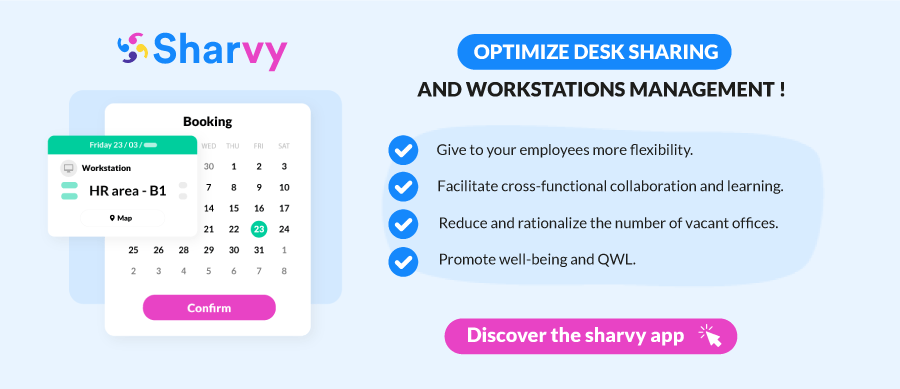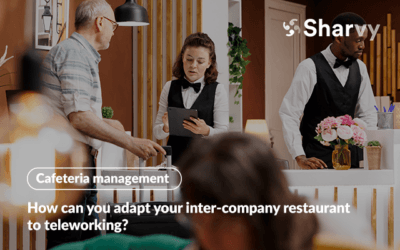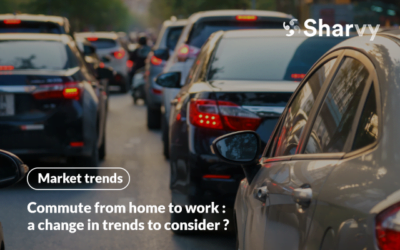There’s no doubt about it : the life of a company, large or small, is punctuated by positive and negative events, decisions, and turning points that need to be taken confidently.
Between the strategic, human, and operational challenges, it’s clear that moving your business is a sensitive event, requiring careful preparation to turn it into a real opportunity for development and growth!
On the other hand, it’s also the perfect opportunity to get off on the right foot again, rethink the layout of your workspaces, and boost the performance of your teams by creating new synergies.
But how do you go about it? In this article, you’ll find valuable advice on planning your business move properly and making the most of it.
A wave of company relocations : facts and explanations.
The episode of the great confinement and the aftermath of the pandemic have made more than one company reflect on its work organization. Hybrid working has become the norm, and we are witnessing a massive and uninhibited adoption of teleworking. There is no turning back.
However, this does have a significant impact on office occupancy rates. In recent years, companies have been bitterly observing many vacant spaces for which they are paying a high price.
As a result, nomadism is dramatically gaining ground within companies and gradually reducing the influence of the fixed workstation. Faced with this phenomenon, companies need to reinvest more strategically. For this reason, they need to move and/or reorganize their workspaces.
But obviously, that’s not the only reason! Whether it’s to refocus their activities, benefit from lower rents, move closer to their core business, take advantage of the emergence of new industrial countries, or breathe new life into their business, many companies choose to move and ask their employees to follow them.
5 ideas to give your company relocation a boost!
Undoubtedly, your company’s move to new premises is an opportunity to design modern working environments driven by technological developments. At the same time, it’s a real opportunity to put elements of well-being and comfort in line with current trends and your employees’ needs.
Below are 5 ideas for rethinking your current working methods and opening up to new practices after your company relocation, that are guaranteed to win the loyalty of your employees.
1. Say goodbye to the rigidity of fixed offices : opt for a flex office in your new premises.
There’s no doubt about it : your company relocation can encourage introducing new working methods, re-conceptualizing your workspaces, and, implicitly, emerging new managerial practices.
In recent years, the forerunners of the flex office have been quick to take advantage of a company move to think about a different way of organizing work. Others see it as an opportunity to seriously rethink the optimization of workplaces at a time when the property is the second most significant item of expenditure for companies, behind salaries.
Whatever the case, the flex office is an innovative way of avoiding the financial losses associated with the desertification of workspaces following the deployment of teleworking policies. At the same time, it means constantly adapting to employees’ new expectations.
At the same time, thanks to the flex office, your employees regain control of their working environment. Each day has its desires, objectives, and affinities. The idea is that each space can be used for a specific purpose. That’s what flexible working is all about the rigidity of fixed offices, the same place every day with the same colleagues in sight, is a thing of the past.
But let’s remember one crucial point.
Behind a project to relocate and, therefore, to reorganize workspaces lies an equally complex and lengthy project of human support and co-creation. How do you support your employees in adopting, accepting, and getting to grips with a new workspace? What role should they play in the design project? What best practices should you remember, and what mistakes should you avoid, to maximize your staff’s enthusiasm for the flex office? We reveal our secrets (free of charge) in our White Paper! Download it here.
✔ Risks to consider
Let’s not forget that moving your company can be a natural source of anxiety for your employees. This is due (mainly) to a loss of reference points. Your employees are leaving a familiar environment for an “unknown” destination. So, while for some, the move is synonymous with “newness” and “adventure”, for others, it’s more challenging to get to grips with a new site and feel at home there.
For example, if a company introduces flex office during its move without first consulting its employees, this can lead to increased stress and absenteeism. Some employees might struggle to find a comfortable workspace every day in the new spaces. This negative impact on workplace well-being can lead to decreased productivity and engagement, highlighting the importance of supporting change.
The challenge is to take account of your employees’ concerns, listen to them, and, above all, provide answers. All the more so if the move allows you to opt for a new way of organizing work: the flex office. Essentially, this involves no longer allocating a specific workstation to an employee.
In other words, you’re asking your staff to move to a new workspace every day, not on the same floor or with the same people. This can mean daily stress and extra fatigue for your employees.
At the same time, the flex office is likely to amplify the ‘workaround’ strategies adopted by some employees to compensate for the disadvantages. For example, arriving early to secure a parking space or choosing the “best” workstation…
So, to ensure that early risers are not spoilt for choice and that places become scarce after 9am, introduce a desk-booking tool like Sharvy. In this way, you depart from the classic flex office approach based on the “first come, first served” principle. Your employees can reserve a place before their arrival and avoid any source of anxiety.
2. Digitalize your new premises by opting for the smart office.
The smart office is currently proving very popular with managers in all sectors.
Why? It’s obvious: the smart office creates a working environment in which new technologies are used to serve the needs and well-being of employees.
In other words, the smart office offers employees an ecosystem of platforms, IoT, services, and various software that significantly improves their performance and, in correlation, the company’s results!
In recent years, many managers have taken advantage of company relocations to go against the traditional organization of their workspaces and (finally) move into an intelligent building.
The initial investment may seem substantial, but you will be okay with it long-term.
Thanks to the smart office, no more hours are spent looking for a meeting room, queuing in the company cafeteria, or looking for a parking space. Information is available in real-time via applications such as Sharvy.
Most of the time, vehicles are recognized as they approach the rising barrier, and users know the number of spaces available and/or the space they need to get to even before they enter the car park.
At the same time, workspaces are allocated according to the needs of their occupants: sitting desks, standing desks, meeting rooms, and so on. Lighting and temperature can be adjusted according to user preferences. A range of technologies that employees appreciate and make them want to come into the office!
✔ Risks to consider
It’s essential to bear in mind that, as yet, there are few standards governing the cyber security of these new buildings. But let’s face it: cyber threats represent a real danger for years to come. It’s easy to imagine a hacker taking control of a smart office. The more technologies there are, the more significant the risks.
At the same time, there are functional risks. Artificial Intelligence (AI) is everywhere in offices (control, access, alarms, etc.). However, AI algorithms need to be regularly updated. In the event of a failure, the operation of the entire premises is at risk. As a result, the risks of going out of business are all the greater with a smart office than with “traditional” premises, which don’t have this type of issue at stake.
3. Take advantage of smart parking to improve your teams’ quality of life.
This is hardly surprising considering that the car park is any journey’s starting point and climax. While it may still seem a secondary concern for many employers, this is far from the case for employees.
Today, more than 68% of British people make their home-to-work journeys by car (Transport Statistics Great Britain).
As a result, and without a company car park, employees’ vehicles are often left unattended on the roads, at risk of being damaged by malicious individuals. Added to this is the fact that many major cities (Paris, Lyon, Marseille, Bordeaux) are rethinking the use of cars in their areas in response to climate issues: shorter parking times, higher charges, etc.
As a result, parking in city centers is becoming increasingly complex. Unfortunately, your employees have to deal with parking restrictions, and the inconvenience this causes and the uncertainty of obtaining parking increases their stress levels.
That’s why more and more employees attach importance to company car parks and consider them one of the most important ways of improving their QWL.
Moving your business can be an opportunity to reverse current trends within your company. In particular, by offering all your employees access to the car park at your new premises.
How can we do this? By pooling your parking spaces, thanks to smart parking. Note that you don’t need to have an opening for each of your employees! The idea is to take advantage of new technologies to optimize vehicle parking. For example, by installing :
- IoT sensors at each parking space (to detect the presence of a vehicle).
- Access control to the car park with automatic barrier opening.
- A number plate recognition system.
- A digital solution enabling users to reserve a parking space.
- Guidance to free spaces using dynamic signposting, etc.
In this way, your employees can find out in real-time how entire a car park is and/or what parking facilities are available (PRM, two-wheeler, with a recharging point, etc).
Especially now that digital technologies have been integrated, the management possibilities are infinite! Companies can now devise rules for good use, systems for prioritizing and/or sharing spaces between users, fairness rules, etc.
Your company’s move can be an opportunity to offer your employees and visitors a positive parking experience. What’s more, you’ll save them considerable time (in addition to their travel time) looking for a parking space. As a result, you’re making a (tangible) contribution to your employees’ Quality of Life and Working Conditions (QWL).
✔ Risks to consider
One thing is sure: offering all your employees access to the company car park is insufficient to improve their daily lives.
The reason is apparent: with a (web & mobile) Parking Management application, you can obtain real, objective data on using your car park. This lack of statistics and unsuccessful car park management could mean that your car park becomes saturated or under-utilized in the future.
In addition, remember to target the measures that will form the pillars of your parking policy. For example, you could consider :
- Incentives measures : encouraging (more) rational use of the car by your employees while at the same time making use of soft mobility. For example, please encourage them to carpool by guaranteeing a space in the company car park.
- Preferential measures : employees with this access will be allocated a space in the car park. For example, you can offer preferential access for people with reduced mobility.
- Penalizing measures : although they are often misunderstood, they are extremely effective. For example, you can establish a transparent system of penalties and take steps to investigate all those who break the rules of your parking policy and the procedures laid down by your company.
4. Modernize your employees’ journey with Sharvy!
Remember that your employees waste precious time and energy on tasks and activities with no added value : looking for a parking space, finding a free workstation (particularly in large companies), queuing in the catering area, etc.
Your company’s move should allow you to rethink and modernize your staff’s career path.
This is a point to be considered because, with the new paradigms in the world of work, the challenge for companies is to give meaning to their employees’ presence in the office. They have to learn how to manage employees whom they only physically see 40% to 60% of the time (and even then), not all simultaneously and not necessarily in a controlled way.
Companies wishing to make teleworking and flex office work sustainable must, therefore, rethink (in-depth) all their systems, bearing in mind that an employee who moves to their workplace must find added value there in the best possible conditions.
It’s a good idea to modernize and make it easier for your staff to arrive on-site when you move in, using a dedicated solution like Sharvy.
For example, allow teleworking employees to reserve, from home and in just a few clicks, the spaces they will need in the company when they return: an office, a meeting room, a meal in the canteen at a less busy time, a parking space, etc.
✔ Risks to consider
One (almost) inevitable risk is resistance to change. Your teams may fear change because it’s destabilizing, stressful, and time-consuming. That’s why you need to anticipate change well and support your staff as they embark on this new way of organizing their work.
It would help if you didn’t impose this overnight. Remember to ask them for regular feedback before you move to ensure your transition is a success. In this way, you show that the change is not being imposed on them and that they are the actors.
At the same time, put in place an acculturation process. This will reduce many aspects of resistance to change!
5. Create a real collaborative hub with corpoworking.
There’s no doubt about it : when a company moves into new premises, it’s also an opportunity to design modern working environments that make the workplace more dynamic.
With this in mind, and far from being a temporary phenomenon, corpoworking spaces are booming and, above all, in phase with changes in the world of work.
More and more employers are looking to set up a space on their premises similar to a third place, where employees from the same company can work together and outsiders (freelancers, service providers, freelancers, and young start-ups).
The aim? To offer employees alternative workspaces that are conducive to learning and brainstorming.
Corpoworking spaces are stimulating and bring real added value to coming to the office. They help erase the boundaries between a company’s business lines and encourage cross-functional collaboration and cooperation. At the same time, they bring together skills that were previously classed within departments.
Whatever the case, by creating a corpoworking space within your new premises, you are responding to an increasingly common need among your employees: to recreate the feeling of belonging to a community.
The creation of this type of space ultimately acts as a rallying point for all talents, where synergies are created through corporate events.
✔ Risks to consider
If you create a corpoworking space on your new premises, notice that outsiders (customers, service providers, freelancers, start-ups) will enter your premises and rub shoulders with your staff.
This can pose problems for the confidentiality of specific data (if this issue needs to be tackled head-on).
That’s why confidentiality rules need to be defined in advance. For example, it is a good idea to invest in IT solutions, such as private WiFi in the corpoworking space and a dematerialized cloud. In the same vein, remember to manage access carefully – entry and exit – (via access control) and to classify the areas of the company to which outsiders do not have access rights.
In conclusion
Ultimately, the move is a corporate project that allows managers to drive change, rethink how they work, and organize their real estate.
There’s no doubt about it: it offers employers new avenues of innovation to explore! Mainly, as the new paradigms in the world of work mean that office occupancy rates are plummeting, it has become crucial for employers to rethink previously established practices.
A question? Check the following FAQ!
What are the essential steps in organizing a smooth company relocation?
A company relocation cannot be improvised. It requires clear, orderly organization so as not to compromise your business or your employees’ work. Once you’ve established the feasibility of your project, here are the 8 steps you shouldn’t overlook :
- Set the date for the company relocation.
- Communicate internally to make the company relocation a success.
- Appoint coordinators who will be responsible for allocating tasks for the company relocation.
- Involve your teams in the company relocation (in the definition & layout of future offices, etc.).
- Select your service providers, then inventory your furniture and equipment for the company relocation.
- Start packing, transfer your contracts, and change your address.
- Organize the day of the company relocation and the days that follow.
- Modernize your staff’s journey before the company relocation : set up a workspace reservation system, access to company car parks, etc.
Multiplying company sites & managing multi-site car parks: how do you go about it?
While the company’s head office may move, the employer may also choose to keep certain subsidiaries.
In this scenario, employees may rotate from one site to another. While some will make these journeys for a day, others will be obliged by their duties to be at one site two or three days a week and at another the rest of the time.
However, the multiplication of company sites and car parks makes it difficult for users to obtain visibility of the availability of parking spaces. At the same time, multimodality is not encouraged, and users waste a considerable amount of time looking for parking close to their place of work. All the more so because if they had yet to anticipate this point, it could jeopardize their ability to keep to their timetable.
This increased flexibility brings with it several organizational challenges, particularly when it comes to managing multi-site car parks.
To overcome these problems, you can unify access management for all your company’s sites by opting for a centralized SaaS solution, such as Sharvy.
This type of solution is compatible with many access control systems (RFID badges & cards, IoT modules, cameras, etc.). Beyond this advantage, these solutions help to harmonize practices and facilitate the management of multi-site car parks.
They also offer your staff dynamic and, above all, real-time monitoring of your multi-site car parks. This means they can see whether parking is available in your car parks. On a day-to-day basis, they can better anticipate their needs and means of transport!
How to manage the impact of the move on employee productivity?
A company relocation can temporarily disrupt productivity, especially if employees are not well prepared for the changes. To minimize this impact, it is essential to plan the transition carefully and rethink your workspace to align with the professional life needs of your teams. For example, prioritizing open and flexible office spaces, which promote creativity and collaborative work, can help boost post-move productivity.
Consider also creating collaborative workspaces or third places that encourage interaction and innovation. Involving your teams in the design of the new spaces and inviting them to take ownership of their personal and shared workspaces can strengthen their engagement and sense of well-being. Moreover, a modern and comfortable work environment can improve the quality of work life, thereby reducing disruptions related to the move.
How can an office relocation transform the workplace in terms of parking?
Relocating a company is a great opportunity to rethink not just the office layout, but also access to parking. By introducing shared workspaces, coworking areas or hot-desking, the company can support a more dynamic working environment while adapting parking spaces for hybrid workers, freelancers, and staff with fixed desks.
Providing meeting rooms close to well-designed parking areas and offering flexible parking solutions helps improve time management and commuting ease. This aligns with new workplace models focused on flexibility, collaboration, and accessibility — key factors in attracting start-ups and meeting the expectations of modern, agile teams working in smart office environments.
Want to learn more? Check out our latest articles!
How can your inter-company restaurant adapt to teleworking?
Teleworking : how can you manage the number of people using your inter-company restaurant & adapt your offer to new working habits? Focus.
Change management : how to facilitate the adoption of a new tool?
What are the essential steps to facilitate change management in your company ? Our advice and best practices can be found here.
Commute from home to work : a change in trends to consider ?
Commute from home to work : what trends can be observed? What are the risks? How can they be improved? Focus in this article.
Subscribe to our newsletter!
Resources
Contact us
+44 117 463 6990







